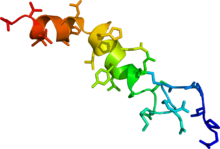
Narcolepsy
Human sleep disorder / From Wikipedia, the free encyclopedia
Dear Wikiwand AI, let's keep it short by simply answering these key questions:
Can you list the top facts and stats about Narcolepsy?
Summarize this article for a 10 year old
Narcolepsy is a chronic neurological disorder that involves a decreased ability to regulate sleep–wake cycles.[1] Symptoms often include periods of excessive daytime sleepiness and brief involuntary sleep episodes.[1] Narcolepsy paired with cataplexy is evidenced to be an autoimmune disorder.[3] These experiences of cataplexy can be brought on by strong emotions. Less commonly, there may be vivid hallucinations or an inability to move (sleep paralysis) while falling asleep or waking up. People with narcolepsy tend to sleep about the same number of hours per day as people without it, but the quality of sleep tends to be lessened.[1]
| Narcolepsy | |
|---|---|
 | |
| The concentration of orexin-A neuropeptides in the cerebrospinal fluid of narcoleptic individuals is usually very low | |
| Pronunciation | |
| Specialty | Sleep medicine, neurology |
| Symptoms | Excessive daytime sleepiness, involuntary sleep episodes, sudden loss of muscle strength, hallucinations[1] |
| Complications | Motor vehicle collisions, falls[1] |
| Usual onset | Childhood[1] |
| Duration | Long term[1] |
| Causes | Orexin deficiency[1] |
| Risk factors | Family history, brain injury[1] |
| Diagnostic method | Based on the symptoms and sleep studies[1] |
| Differential diagnosis | Sleep apnea, major depressive disorder, anemia, heart failure, drinking alcohol, idiopathic hypersomnia, Sleep deprivation[1] |
| Treatment | Medication, regular short naps, sleep hygiene[1] |
| Medication | Modafinil, sodium oxybate, pitolisant, methylphenidate, amphetamine, stimulants, antidepressants[1] |
| Frequency | 0.2 to 600 per 100,000[2] |
Narcolepsy is a clinical syndrome of hypothalamic disorder,[4] but the exact cause of narcolepsy is unknown, with potentially several causes.[5] In up to 10% of cases, there is a family history of the disorder. Often, those affected have low levels of the neuropeptide orexin, which may be due to an autoimmune disorder triggered in genetically susceptible individuals by infection with H1N1 influenza.[6] In rare cases, narcolepsy can be caused by traumatic brain injury, tumors, or other diseases affecting the parts of the brain that regulate wakefulness or REM sleep. Diagnosis is typically based on the symptoms and sleep studies, after ruling out other potential causes. Excessive daytime sleepiness can also be caused by other sleep disorders such as sleep apnea, major depressive disorder, anemia, heart failure, drinking alcohol and not getting enough sleep. The accompanying cataplexy may be mistaken for seizures.[1]
While there is no cure, a number of lifestyle changes and medications may help. Lifestyle changes include taking regular short naps and sleep hygiene. Medications used include modafinil, sodium oxybate and methylphenidate. While initially effective, tolerance to the benefits may develop over time. Tricyclic antidepressants and selective serotonin reuptake inhibitors (SSRIs) may improve cataplexy.[1]
Estimates of frequency range from 0.2 to 600 per 100,000 people in various countries.[2] The condition often begins in childhood, with males and females being affected equally. Untreated narcolepsy increases the risk of motor vehicle collisions and falls.[1]
Narcolepsy generally occurs anytime between early childhood and 50 years of age, and most commonly between 15 and 36 years of age. However, it may also rarely appear at any time outside of this range.[7]